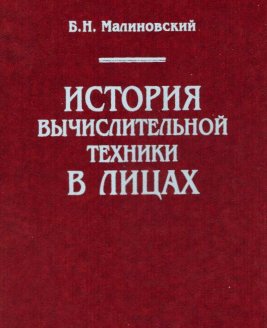Boris N. Malinovsky: Pioneers of Soviet Computing (1995–) [RU, EN]
Filed under book | Tags: · computing, cybernetics, history of computing, history of science, history of technology, soviet union, technology

Boris N. Malinovsky’s Pioneers of Soviet Computing is the English language version of his earlier Russian language The History of Computing in Personalities (in Russian: История Вычислительной Техники в Лицах). Partly technical history and partly a memoir, it is the only existing first person account of the birth of modern computing in Russia, Ukraine, and Belarus. It chronicles the life and work of renowned Soviet computer scientists S.A. Lebedev, V.M. Glushkov, N.P. Brusentsov, I.S. Brook, and many others. It describes numerous indigenous and original Soviet computer hardware projects from the end of the Second World War through the decades that followed, interlaced with commentary on the Soviet political and social systems that constrained rapid and free technological advancement. In addition, this work reviews the various Russian and Ukrainian computing schools ranging from the highly philosophical cybernetics and artificial intelligence to the applied defense computing institutions supporting the military and weapons enterprises. The epic effort to mass produce the Unified System (ES) series of computers – based on the IBM 360 design – is described in depth, along with the political and bureaucratic intrigue and personal and technological struggles that accompanied.
Subjects: Soviet Union, USSR, Electronic Computing, Science, Defense, MESM, BESM, ES, Elbrus, Setun, Cybernetics, Control Computers, Ternary.
Publisher KIT, Kiev, 1995
ISBN 5770761318
384 pages
English edition
Edited by Anne Fitzpatrick
Translated by Emmanuel Aronie
Editorial consultant: Kate Maldonado
First published in 2006
Published electronically by SIGCIS, 2010
Creative Commons license BY-ND 3.0
Authors (via Internet Archive)
Publisher (EN)
via Aymeric Mansoux
Istroiya vychislitelnoy techniki v litsach (Russian, 1995, HTML, added on 2015-1-13)
, Pioneers of Soviet Computing (English, 2nd ed., 2006/2010)
George Saliba: Islamic Science and the Making of the European Renaissance (2007)
Filed under book | Tags: · astronomy, history of science, islam, renaissance, science

The Islamic scientific tradition has been described many times in accounts of Islamic civilization and general histories of science, with most authors tracing its beginnings to the appropriation of ideas from other ancient civilizations—the Greeks in particular. In this thought-provoking and original book, George Saliba argues that, contrary to the generally accepted view, the foundations of Islamic scientific thought were laid well before Greek sources were formally translated into Arabic in the ninth century. Drawing on an account by the tenth-century intellectual historian Ibn al-Nadīm that is ignored by most modern scholars, Saliba suggests that early translations from mainly Persian and Greek sources outlining elementary scientific ideas for the use of government departments were the impetus for the development of the Islamic scientific tradition. He argues further that there was an organic relationship between the Islamic scientific thought that developed in later centuries and the science that came into being in Europe during the Renaissance.
Saliba outlines the conventional accounts of Islamic science, then discusses their shortcomings and proposes an alternate narrative. Using astronomy as a template for understanding the progress of science in Islamic civilization, Saliba demonstrates the originality of Islamic scientific thought. He details the innovations (including new mathematical tools) made by the Islamic astronomers from the thirteenth to sixteenth centuries, and offers evidence that Copernicus could have known of and drawn on their work. Rather than viewing the rise and fall of Islamic science from the often-narrated perspectives of politics and religion, Saliba focuses on the scientific production itself and the complex social, economic, and intellectual conditions that made it possible.
Publisher MIT Press, 2007
Transformations: Studies in the History of Science and Technology series
ISBN 0262195577, 9780262195577
315 pages
PDF (updated on 2013-6-2)
Comment (0)Charles Howard Hinton: The Fourth Dimension (1904/1912); A New Era of Thought (1888)
Filed under book | Tags: · geometry, history of science, mathematics, science fiction, theosophy, time

In an 1884 article entitled “What is the Fourth Dimension?”, Hinton suggested that points moving around in three dimensions might be imagined as successive cross-sections of a static four-dimensional arrangement of lines passing through a three-dimensional plane, an idea that anticipated the notion of world lines, and of time as a fourth dimension (although Hinton did not propose this explicitly, and the article was mainly concerned with the possibility of a fourth spatial dimension), in Einstein’s theory of relativity. Hinton later introduced a system of coloured cubes by the study of which, he claimed, it was possible to learn to visualise four-dimensional space (Casting out the Self, 1904). Rumours subsequently arose that these cubes had driven more than one hopeful person insane.
Hinton created several new words to describe elements in the fourth dimension. According to OED, he first used the word tesseract in 1888 in his book “A New Era of Thought”. He also invented the words “kata” (from the Greek “down from”) and “ana” (from the Greek “up toward”) to describe the two opposing fourth-dimensional directions—the 4-D equivalents of left and right, forwards and backwards, and up and down.
Hinton’s Scientific romances, including “What is the Fourth Dimension?” and “A Plane World” were published as a series of nine pamphlets by Swan Sonnenschein & Co. during 1884–1886. In the introduction to “A Plane World”, Hinton referred to Abbott’s recent Flatland as having similar design but different intent. Abbott used the stories as “a setting wherein to place his satire and his lessons. But we wish in the first place to know the physical facts.” Hinton’s world existed on the surface of a sphere rather than a flat plane. He extended the connection to Abbott’s work with “An Episode on Flatland: Or How a Plain Folk Discovered the Third Dimension” (1907).
The Fourth Dimension
Third Edition
Published by London: George Allen & Co, 1912
PDF
Read online (1884 article) (HTML)
A New Era of Thought
Publisher London: Swan Sonneschen & Co, 1888
PDF
Read online (HTML)

